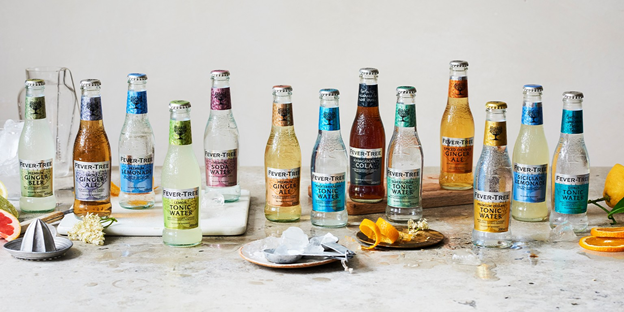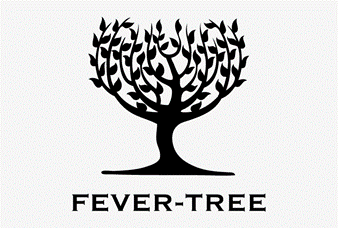A Twist to Your Drinks: How does this company position itself as a PREMIUM yet accessible brand? [Monday: Marketing Marvels]

What’s your taste preference when it comes to mixed drinks?
Sweet?
Tangy?
A bit minty and spicy?
Tell us what you want—anything!
Whatever your preference is, this company makes sure that it gives you the flavor you want and deserve!
Fevertree Drinks Plc, or Fever-Tree, is a British manufacturing company of premium drink mixers. It was founded by businessmen Charles Rolls and Tim Warrillow in 2004.
[Drink Mixers: Pertains to non-alcoholic ingredients in mixed drinks and cocktails.]
Some of the company’s products include:
- Indian Tonic Water
- Premium Soda Water
- Sicilian Lemonade
- Madagascan Cola
- Ginger Beer
- Bitter Lemon
According to the World’s 50 Best Bars Annual Report in 2016, Fever-Tree is the world’s leading premium mixer brand. As of 2020, the company has distribution networks in more than 75 countries.

What strategies does the company employ to strengthen its position in the drink mixer category?
-
Capitalizing on Market Trends
According to Fever-Tree’s 2019 annual report, the trend towards spirits premiumization continues to grow
(Spirits = liquor that contains no added sugar and has at least 20% alcohol by volume)
The company benefits from the continued popularity of premium gin and tonic in the UK, Western Europe, Australia, and Canada.
This trend, which includes the emergence of the Spritz Serve and resurgence of the Moscow Mule in the US, reflects the opportunities Fever-Tree has to expand its market reach.
Fever-Tree assures consumers that it will continue to tell its unique brand story through these drinks and strengthen its position as a pioneer in the Premium Mixer category.
-
Strengthening Distribution in Existing Markets and Identifying New Markets
Fever-Tree is ready to take on the world by increasing its reach in all of its markets!
In fact, the company is ramping up marketing efforts to tap into “Gin Renaissance” in the UK.
According to Saskia Meyer, Fever-Tree’s Marketing Director, the company is focusing on driving distribution, educating bartenders and pub managers, conducting events, and establishing partnerships with gin brands.
The London urban audience is a strategic market for Fever-Tree. In an effort to raise awareness about its products, the company uses out-of-home (OOH) advertising, placing posters in train and bus stations and other public places.
Do you think that’s all that the company is doing?
Of course not!
Fever-Tree is also “pioneering a new mixer category” with the tagline:
“If ¾ of your cocktail is the MIXER, make sure you use THE BEST.”
As stated in its 2019 annual report, since good quality ingredients were replaced by other businesses with cheap alternatives such as artificial sweeteners, colors, and flavors in the past years, the company encourages consumers to not settle for less in their mixed drinks.
In other words, buy Fever-Tree’s products because they are “the best!”
The brand also launched the UK’s first canned, all-natural tonic water, which was introduced to British Airways passengers in August 2015.
After seeing that there’s interest in premium mixers and tonic waters in the market, soft drink companies also joined in on the trend.
One example is soft drinks manufacturer Bottle Green, which recently launched its own tonic waters for mixing.
Clearly, Fever-Tree is pioneering a growing trend, seeing how other brands are following its footsteps!
-
Extending Co-Promotion Strategies with Drinks Partners
The company continues to broaden its relationship with spirits companies not only to earn more profit, but also to demonstrate the value of co-promotion to both parties.
So far, Fever-Tree has conducted over 300 co-promotion activities around the world.
Some of these activities are:
-
Co-branding with Patrón Tequila to create the Citrus Tonic Water
-
Partnering with Caffѐ Nero for the Espresso & Tonic drink
-
Coordinating with Bryant Park, Midtown Manhattan’s premier public space, to set up a Fever-Tree Porch—a store where people can unwind and enjoy a few drinks with their friends
The company aims to further engage in co-branded promotional activities to reflect its commitment in the drink mixer category.
-
-
Innovating on New Flavors to Offer to Consumers
Fever-Tree operates with a mission:
“To combine the highest quality naturally sourced ingredients with expert manufacturing techniques to produce an unrivalled drinks experience.”
As a pioneer in the premium mixer category, innovation remains at the heart of the company’s strategy.
Commitment to sourcing the highest quality ingredients is crucial and every year, the Fever-Tree team travels to different places to meet with key suppliers and identify potential partners.
Part of the company’s innovation is extending the range of its ginger mix products such as the Spiced Orange and Smoky Ginger Ales, as well as launching a new range of sodas for the UK market.
Aside from that, Fever-Tree also plans to introduce a Sparkling Pink Grapefruit Soda in the US market. The mixer is made to be mixed with Tequila or Vodka, 2 of the largest spirits categories in the country.
As the company’s global footprint continues to grow, opportunities remain to ensure its products reflect the drinking habits and taste profiles of consumers all over the world.
In the past five years, Fevertree Drinks Plc has recorded revenues of:
- GBP 59.3 million in 2015
- GBP 102.2 million in 2016
- GBP 170.2 million in 2017
- GBP 237.4 million in 2018
- GBP 260.5 million in 2019
Clearly, the company’s strategies contribute to helping its business expand and grow to its full potential in the drink mixer category.
Fevertree Drinks Plc’s Earning Power: Valens Research vs. As-reported numbers
Fevertree Drinks Plc (FEVR: GBR) makes for a great case study that we come back to regularly. One great reason?
The company has proven itself to be a better earning power generator than investors might think.
So, how well has Fever-Tree been growing its business in the past years?
The research doesn’t lie—nor do the results. Earning power (the blue bars) continues to show results higher on average than what traditional databases show.
The blue bars in the chart above represent Fever-Tree’s earning power (Uniform Return On Assets). Fever-Tree has seen generally robust profitability. Its Uniform ROA ranged from 49% to 108% in the past nine years, or an average of 79%. Uniform ROA is at 87% in 2019.
The global ROA is just 6%.
The orange bars are the company’s as-reported financial information. If you relied on these numbers, you will see a company with terribly understated profitability. As-reported ROA (return on assets, a measure of earning power) only ranged from 6% to 28% in the past eight years. Its ROA in 2019 was only at 19%, far lower than its Uniform ROA in 2019.
That’s what you’ll see in Yahoo Finance, Google Finance, and most other databases.
The company’s stock price also performed better than the rest of the stock market over the decade, which we can see in the blue line in the chart below. Its returns have been well above the market.
The numbers show that Fever-Tree has been doing well and making a profit.
According to Bill Ronald, Fever-Tree’s Chairman, the company was built on the belief that “there had to be a better way to not compromise or accept the status quo.”
This belief remains at the core of Fever-Tree’s operations to inspire and engage its employees, partners, and consumers in the pursuit of the best products and flavors.
That is why the company focuses on quality over quantity in everything it does, even if it means going to the ends of the earth to look for the highest quality ingredients.
After all, why wouldn’t Fever-Tree want to make the most out of its business?
As stated by Ronald, “Life is too short [for the company] to compromise [the quality of its products].”
About The Dynamic Marketing Communiqué’s
“Monday Marketing Marvels”
Too often, industry experts and the marketing press sing the praises of some company’s marketing strategy.
…Only for the audience to later find out that their product was a flop, or worse, that the company went bankrupt.
The true ROI in marketing can’t be separated from the business as a whole.
What good is a marketing case study if one can’t prove that the company’s efforts actually paid off?
At the end of the day, either the entire business is successful or it isn’t. And the role of marketing is always paramount to that success.
Every Monday, we publish a case study that highlights the world’s greatest marketing strategies.
However, the difference between our case studies and the numerous ones out there, is that we will always make certain that the firm really did generate and demonstrate earning power worthy of study in the first place (compliments of Valens Research’s finance group).
By looking at the true earnings of a company, we can now rely on those successful businesses to get tips and insights on what they did right.
We’ll also study the greatest marketing fails and analyze what they did wrong, or what they needed to improve on. We all make our mistakes, but better we learn from others’ mistakes—and earlier, rather than later.
Hope you found this week’s marketing marvel interesting and helpful.
Stay tuned for next week’s Monday Marketing Marvels!
Cheers,
Kyle Yu
Head of Marketing
Valens Dynamic Marketing Capabilities
Powered by Valens Research
www.valens-research.com











